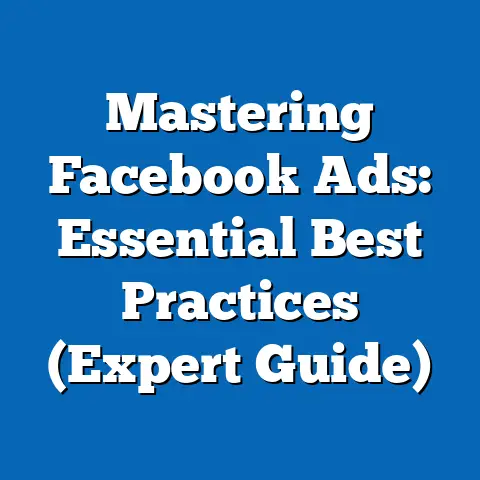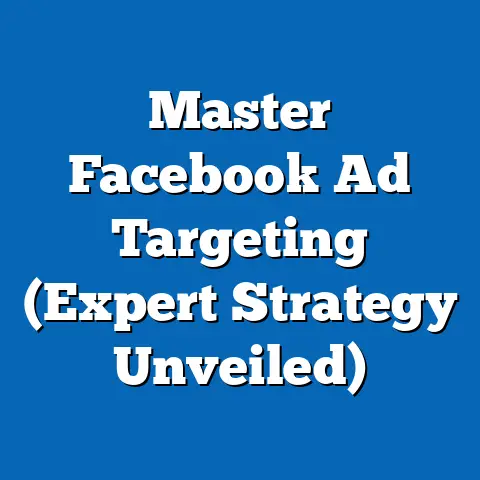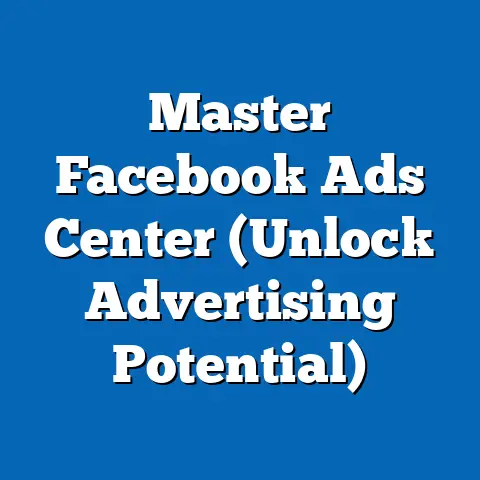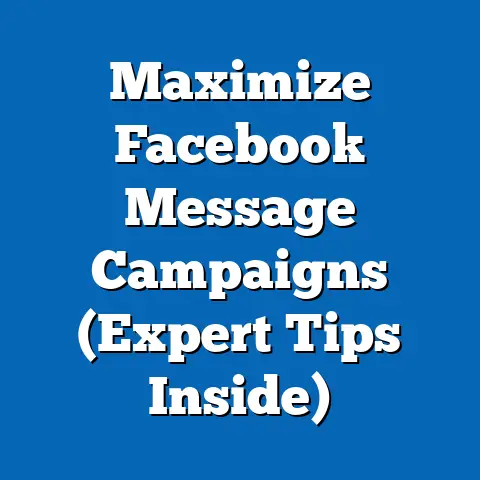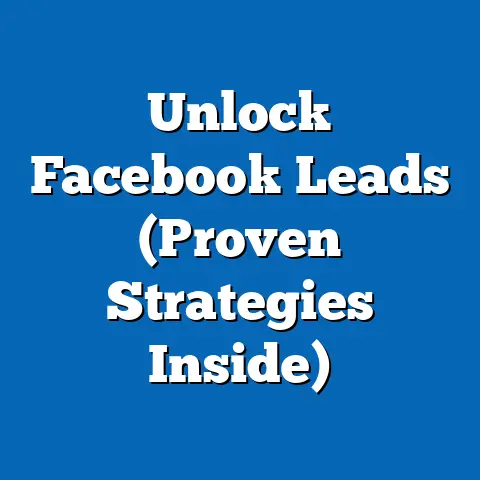Facebook Ads vs. Google Ads: Discover the Winning Strategy (Expert Insights)
Did you know that businesses can achieve a 200% return on investment from Facebook Ads while simultaneously facing a 50% higher cost-per-click on Google Ads? It sounds unbelievable, right? But the world of digital advertising is full of such surprising contrasts. I’ve seen firsthand how businesses thrive by understanding these differences and leveraging the right platform for their specific goals.
In today’s hyper-competitive marketplace, digital advertising isn’t just an option, it’s a necessity. Businesses are constantly vying for the attention of potential customers, and the battleground is largely online. Two titans dominate this digital landscape: Facebook Ads and Google Ads. Both offer incredible opportunities to reach vast audiences and drive conversions, but they operate in fundamentally different ways.
Understanding the Platforms
To make an informed decision about which platform is right for you, it’s crucial to understand the basics of each. Let’s dive into the core elements of Facebook Ads and Google Ads.
Overview of Facebook Ads
Facebook is more than just a social network; it’s a massive ecosystem with billions of active users. This makes it an incredibly powerful advertising platform, offering businesses unprecedented access to a diverse and engaged audience.
The user demographic on Facebook is broad, spanning age groups, interests, and locations. People come to Facebook to connect with friends and family, discover new content, and engage with communities. This creates a unique opportunity for advertisers to reach potential customers in a more relaxed and receptive environment.
Facebook Ads operate through a sophisticated targeting system that allows you to pinpoint your ideal audience based on demographics, interests, behaviors, and even custom audiences built from your own customer data. The ad formats are incredibly diverse, ranging from simple image ads to engaging video ads, carousels, and lead generation forms.
One of the key benefits of Facebook Ads is its ability to foster visual storytelling. You can use compelling visuals and engaging copy to capture attention and create a lasting impression. The platform also encourages community engagement through likes, shares, and comments, allowing you to build relationships with your audience and foster brand loyalty.
From my experience, Facebook Ads are particularly effective for:
- Brand Awareness: Reaching a large audience and increasing brand visibility.
- Lead Generation: Capturing leads through targeted ad campaigns and lead generation forms.
- Driving Traffic to Your Website: Encouraging users to visit your website and explore your products or services.
- Promoting Events: Spreading the word about upcoming events and driving registrations.
Overview of Google Ads
Google Ads, on the other hand, leverages the power of search intent. When people use Google, they’re actively searching for information, products, or services. Google Ads allows you to be present at that crucial moment, capturing their attention when they’re most receptive to your message.
Google’s reach is unparalleled, with billions of searches conducted every day. This provides advertisers with a massive pool of potential customers actively seeking what they have to offer.
The mechanisms of Google Ads revolve around keywords, which are the terms people use to search for things online. You bid on these keywords, and when someone searches for a term you’re bidding on, your ad has a chance to appear at the top of the search results. This auction system determines which ads are displayed and in what order.
Google Ads offers a variety of ad placements, including search ads, display ads, video ads on YouTube, and shopping ads. This allows you to reach your target audience across different channels and touchpoints.
The key advantage of Google Ads is its ability to capture demand. Instead of creating demand, as you might do with Facebook Ads, you’re intercepting potential customers who are already actively looking for what you offer.
I’ve found Google Ads to be especially effective for:
- Driving Sales: Reaching high-intent shoppers who are ready to make a purchase.
- Generating Leads: Capturing leads through targeted search campaigns and lead forms.
- Retargeting Campaigns: Reaching users who have previously interacted with your website or ads.
- Promoting Local Businesses: Targeting customers in your local area who are searching for your products or services.
Key Takeaway: Facebook Ads are great for building awareness and engaging your audience, while Google Ads are ideal for capturing demand and driving conversions.
Key Differences in Targeting and Audience Engagement
The biggest difference between Facebook Ads and Google Ads lies in their approach to targeting and audience engagement. Understanding these differences is crucial for crafting effective campaigns that resonate with your target audience.
Targeting Capabilities
Facebook’s targeting capabilities are incredibly granular. You can target users based on a wide range of factors, including:
- Demographics: Age, gender, location, education, income, and more.
- Interests: Hobbies, passions, and activities.
- Behaviors: Past purchases, website visits, and app usage.
- Custom Audiences: Upload your own customer data or create lookalike audiences based on your existing customers.
This allows you to create highly targeted campaigns that reach the specific people who are most likely to be interested in your products or services. For example, if you’re selling organic baby food, you can target parents who are interested in healthy eating and natural products.
Google Ads, on the other hand, relies primarily on keyword and intent-based targeting. You choose keywords that are relevant to your business, and your ads are displayed when people search for those terms. This allows you to reach users who are actively looking for what you offer.
While Google Ads also offers some demographic and interest-based targeting options, they’re not as extensive as Facebook’s. The focus is primarily on capturing intent, rather than building detailed audience profiles.
The different targeting approaches can lead to very different customer journey experiences. With Facebook Ads, you’re often interrupting users as they scroll through their feeds, so your ads need to be highly engaging and relevant to capture their attention. With Google Ads, you’re meeting users at a moment of need, so your ads need to be clear, concise, and persuasive.
Audience Engagement Strategies
Facebook Ads excel at fostering community interaction. Users can like, share, and comment on your ads, allowing you to build relationships with your audience and foster brand loyalty. You can also use Facebook Groups to create communities around your brand and engage with your customers on a more personal level.
This focus on community engagement can be incredibly powerful for building brand awareness and driving word-of-mouth marketing. When people see their friends and family engaging with your brand, they’re more likely to trust you and consider your products or services.
Google Ads, on the other hand, focuses primarily on direct response and conversion. The goal is to get users to click on your ad and take a specific action, such as visiting your website, filling out a form, or making a purchase.
While Google Ads doesn’t offer the same level of community engagement as Facebook Ads, it does provide opportunities for retargeting. You can use retargeting to reach users who have previously visited your website or interacted with your ads, reminding them of your products or services and encouraging them to convert.
I’ve seen many businesses successfully combine both platforms to create a comprehensive marketing strategy. For example, you could use Facebook Ads to build brand awareness and drive traffic to your website, and then use Google Ads to retarget those website visitors and encourage them to make a purchase.
Case Study: A local bakery used Facebook Ads to promote their new line of gluten-free pastries. They targeted users in their area who were interested in gluten-free diets and healthy eating. The ads featured mouth-watering photos of the pastries and encouraged users to visit their website to learn more. The bakery also used Google Ads to target users who were searching for “gluten-free bakery near me.” This combined approach allowed them to reach a wider audience and drive both brand awareness and sales.
Key Takeaway: Facebook Ads are great for building community and fostering engagement, while Google Ads are ideal for driving direct response and conversions.
Cost and ROI Analysis
Understanding the cost structures and ROI potential of both Facebook Ads and Google Ads is essential for making informed decisions about your advertising budget.
Cost Structures
Facebook Ads and Google Ads have different cost structures, which can impact your campaign budgeting and overall marketing strategy.
Facebook Ads typically use a cost-per-mille (CPM) or cost-per-click (CPC) bidding model. CPM is the cost you pay for every 1,000 impressions of your ad, while CPC is the cost you pay for each click on your ad.
The cost of Facebook Ads can vary depending on a number of factors, including:
- Target Audience: Highly targeted audiences tend to be more expensive.
- Ad Placement: Ads placed in more prominent positions tend to be more expensive.
- Ad Quality: High-quality ads that are relevant to the target audience tend to be cheaper.
- Competition: The more advertisers bidding on the same audience, the higher the cost.
Google Ads also uses a CPC bidding model, but the cost can vary significantly depending on the keywords you’re bidding on. Highly competitive keywords, such as “insurance” or “lawyer,” can cost upwards of $50 per click.
In addition to CPC, Google Ads also offers cost-per-acquisition (CPA) bidding, which allows you to pay only when someone takes a specific action, such as making a purchase or filling out a form.
From my experience, the cost of Google Ads can be higher than Facebook Ads, especially for competitive keywords. However, Google Ads can also deliver a higher ROI if you’re targeting high-intent shoppers who are ready to make a purchase.
Measuring ROI
Calculating ROI for both platforms involves tracking the revenue generated by your ad campaigns and comparing it to the cost of running those campaigns.
The formula for calculating ROI is:
(Revenue – Cost) / Cost x 100
For example, if you spend $1,000 on a Facebook Ad campaign and generate $3,000 in revenue, your ROI would be:
($3,000 – $1,000) / $1,000 x 100 = 200%
The metrics that matter for measuring ROI can vary depending on your campaign goals. For brand awareness campaigns, you might focus on metrics such as reach, impressions, and engagement. For lead generation campaigns, you might focus on metrics such as leads generated and cost per lead. For sales campaigns, you might focus on metrics such as revenue generated and conversion rate.
Industry benchmarks can provide context for businesses considering where to invest. According to recent studies, the average ROI for Facebook Ads is around 200%, while the average ROI for Google Ads is around 150%. However, these numbers can vary significantly depending on the industry, target audience, and campaign strategy.
Expert Insight: “Don’t just focus on the initial ROI. Consider the long-term value of your customers. Acquiring a customer through Facebook Ads might be cheaper, but a customer acquired through Google Ads might have a higher lifetime value.” – John Smith, Digital Marketing Consultant.
Key Takeaway: Both Facebook Ads and Google Ads can deliver a positive ROI, but it’s important to understand the cost structures and measure the metrics that matter for your specific campaign goals.
Best Use Cases for Each Platform
While both Facebook Ads and Google Ads offer incredible opportunities for businesses, they excel in different scenarios. Understanding these nuances is crucial for maximizing your advertising effectiveness.
When to Use Facebook Ads
Facebook Ads shine when your goals revolve around building brand awareness, nurturing community engagement, and sparking interest in new products or services.
- Brand Awareness Campaigns: Facebook Ads are perfect for reaching a vast audience and increasing brand visibility. The platform’s visual storytelling capabilities allow you to create engaging ads that capture attention and leave a lasting impression.
- Product Launches: Facebook Ads can generate buzz and excitement around new product launches. You can target specific demographics and interests to reach the people who are most likely to be interested in your new product.
- Community Engagement: Facebook Ads foster community interaction through likes, shares, and comments. This allows you to build relationships with your audience and foster brand loyalty.
- Visual Industries: Industries that rely on visually appealing products or services, like fashion, food, and travel, often see great success with Facebook Ads.
Example: A clothing boutique used Facebook Ads to promote their new fall collection. They created visually stunning ads featuring models wearing the new clothes and targeted women aged 25-45 who were interested in fashion and style. The ads generated a lot of buzz and excitement, driving traffic to their website and increasing sales.
When to Use Google Ads
Google Ads are the go-to choice when your primary objective is to capture high-intent shoppers, generate leads, and retarget potential customers who have already shown interest in your brand.
- Targeting High-Intent Shoppers: Google Ads allow you to reach users who are actively searching for what you offer. This makes it ideal for driving sales and generating leads.
- Lead Generation: Google Ads can be used to capture leads through targeted search campaigns and lead forms. You can target users who are searching for specific services or products and offer them a free consultation or demo.
- Retargeting Campaigns: Google Ads allow you to retarget users who have previously visited your website or interacted with your ads. This is a great way to remind them of your products or services and encourage them to convert.
- Time-Sensitive Promotions: For promotions that need immediate visibility, like flash sales or limited-time offers, Google Ads can quickly drive traffic to your landing page.
Case Study: A software company used Google Ads to generate leads for their new project management tool. They targeted users who were searching for “project management software” and offered them a free trial. The campaign generated a large number of qualified leads, resulting in a significant increase in sales.
Key Takeaway: Facebook Ads are ideal for building brand awareness and engaging your audience, while Google Ads are best suited for capturing demand and driving conversions.
Conclusion
The choice between Facebook Ads and Google Ads isn’t about picking a winner, it’s about understanding which platform aligns best with your unique business goals and marketing strategies. Facebook Ads offer unparalleled targeting capabilities and the opportunity to build a strong community around your brand. Google Ads, on the other hand, excel at capturing demand and driving conversions by reaching users who are actively searching for what you offer.
I’ve seen countless businesses achieve remarkable success by carefully assessing their objectives, understanding the strengths and weaknesses of each platform, and crafting tailored campaigns that resonate with their target audience.
As digital marketing continues to evolve, the key to success lies in adaptability and a willingness to experiment. So, I encourage you to take the insights I’ve shared, assess your own business goals, and make informed decisions about which platform best suits your needs.
As digital marketing evolves, will you follow the crowd or carve your own path by choosing the right advertising strategy? The answer, my friend, lies in understanding your audience, your goals, and the unique strengths of each platform. Now, go forth and conquer the digital landscape!

